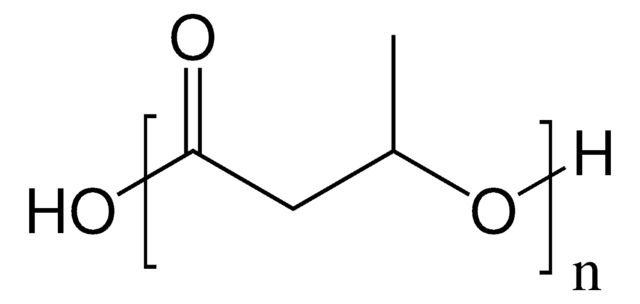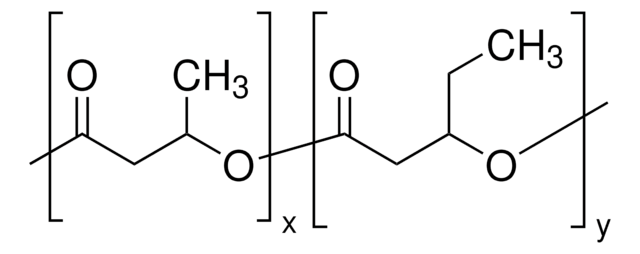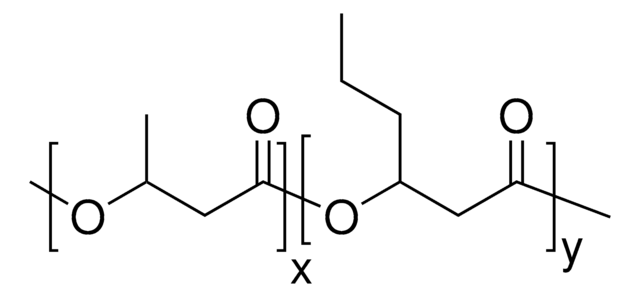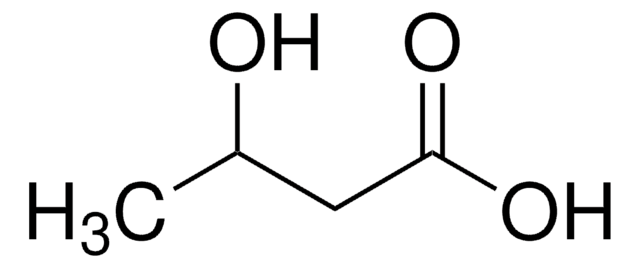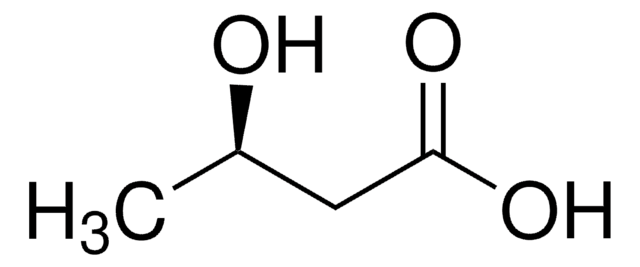363502
Poly[(R)-3-hydroxybutyric acid]
natural origin
Sinônimo(s):
(R)-3-Hydroxybutyric acid polymerized, PHB
Faça loginpara ver os preços organizacionais e de contrato
About This Item
Fórmula linear:
[COCH2CH(CH3)O]n
Número CAS:
Número MDL:
Código UNSPSC:
12162002
ID de substância PubChem:
NACRES:
NA.23
Produtos recomendados
temperatura de transição
Tm 172 °C (DSC)
cadeia de caracteres SMILES
CC(O)CC(O)=O
InChI
1S/C12H20O6/c1-8(14)6-11(15)18-10(3)7-12(16)17-9(2)4-5-13/h5,8-10,14H,4,6-7H2,1-3H3
chave InChI
QLACRIKFZRFWRU-UHFFFAOYSA-N
Procurando produtos similares? Visita Guia de comparação de produtos
Categorias relacionadas
Descrição geral
Biocompatible, biodegradable polymer.
Aplicação
Poly[(R)-3-hydroxybutyric acid (PHB) is a biodegradable and biocompatible polymer produced by several bacterial species, owing to its low resorbability and tunable properties, it may find uses in a variety of applications such as tissue engineering, controlled release systems etc.
Código de classe de armazenamento
11 - Combustible Solids
Classe de risco de água (WGK)
WGK 3
Ponto de fulgor (°F)
Not applicable
Ponto de fulgor (°C)
Not applicable
Escolha uma das versões mais recentes:
Já possui este produto?
Encontre a documentação dos produtos que você adquiriu recentemente na biblioteca de documentos.
Proliferation and skeletal myotube formation capability of C2C12 and H9c2 cells on isotropic and anisotropic electrospun nanofibrous PHB scaffolds.
Ricotti L, et al.
Biomedical Materials (Bristol, England), 7(3), 035010-035010 (2012)
Engineering of Saccharomyces cerevisiae for the production of poly-3-d-hydroxybutyrate from xylose.
Sandstrom A G, et al.
AMB Express, 5(1), 14-14 (2015)
Molecular mass of poly [(R)-3-hydroxybutyric acid] produced in a recombinant Escherichia coli.
Kusaka S, et al.
Applied Microbiology and Biotechnology, 47(2), 140-143 (1997)
Rosetta N Reusch
Chemistry & biodiversity, 9(11), 2343-2366 (2012-11-20)
Poly-(R)-3-hydroxybutyrates (PHB), linear polymers of (R)-3-hydroxybutyrate, are components of all biological cells in which short polymers (<200 monomer residues) are covalently attached to certain proteins and/or noncovalently associated with polyphosphates - inorganic polyphosphate (polyP), RNA, and DNA. The low concentrations
Asli S Ciggin et al.
Bioresource technology, 129, 118-126 (2012-12-13)
The aerobic metabolism of a mixture of acetate and starch was studied with main emphasis on their interaction and the effect on their storage as PHB and glycogen, respectively. Pulse feeding strongly increased the storage of both substrates; however, the
Nossa equipe de cientistas tem experiência em todas as áreas de pesquisa, incluindo Life Sciences, ciência de materiais, síntese química, cromatografia, química analítica e muitas outras.
Entre em contato com a assistência técnica